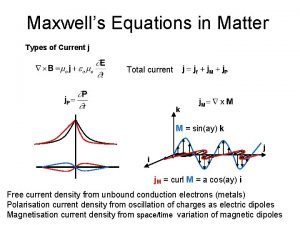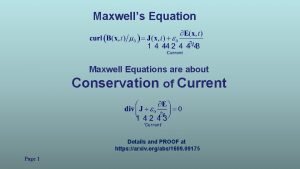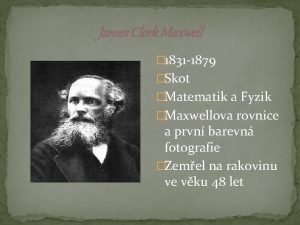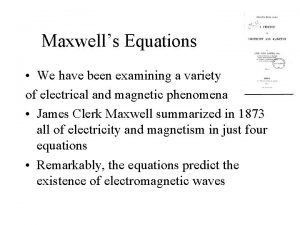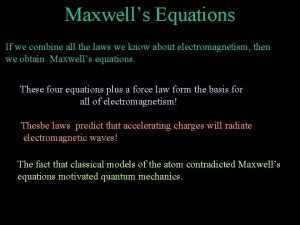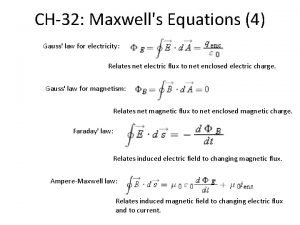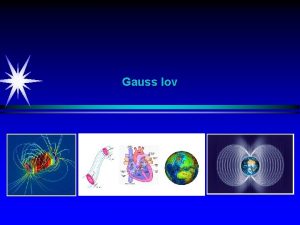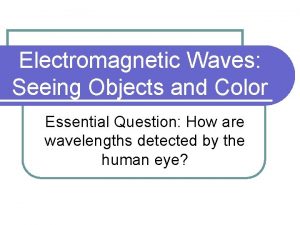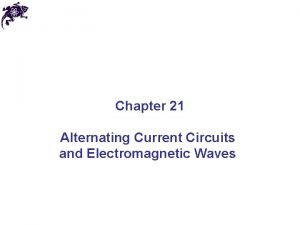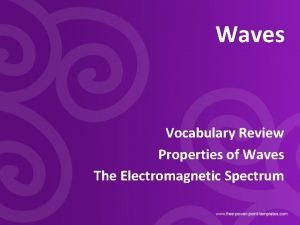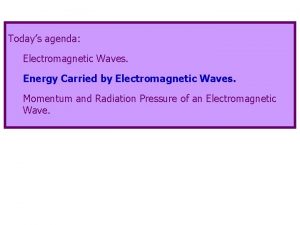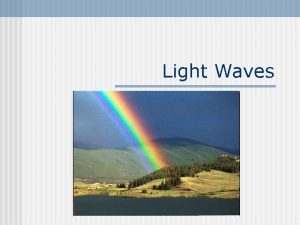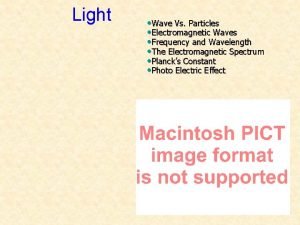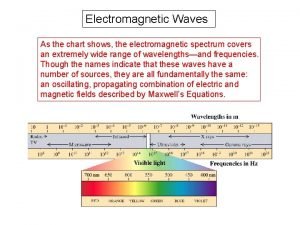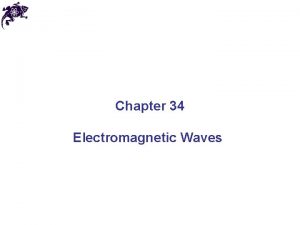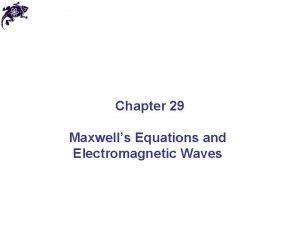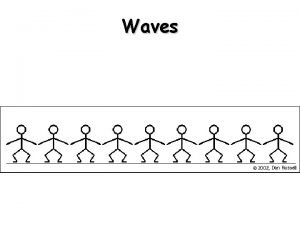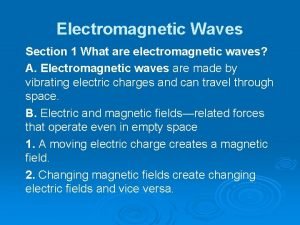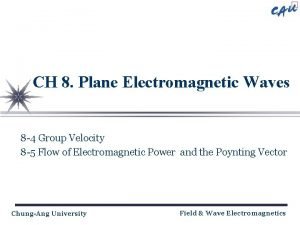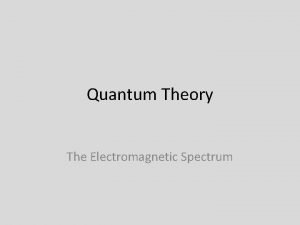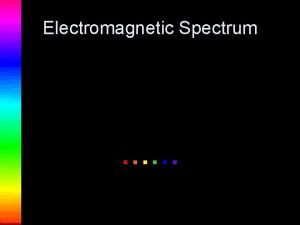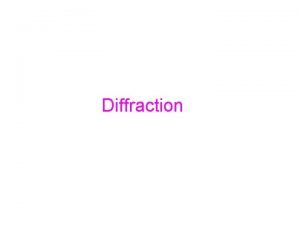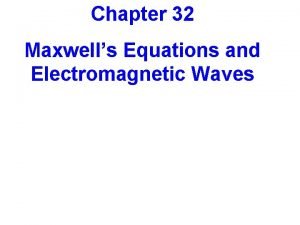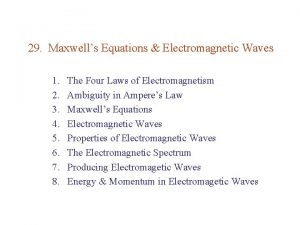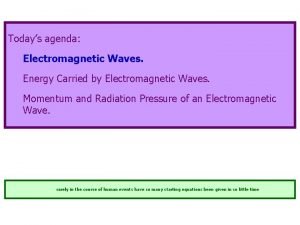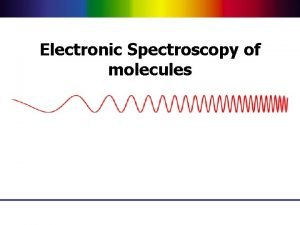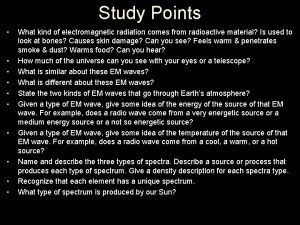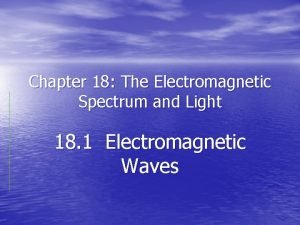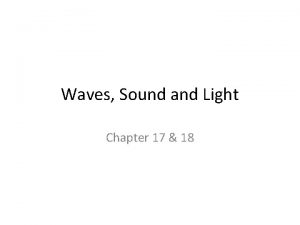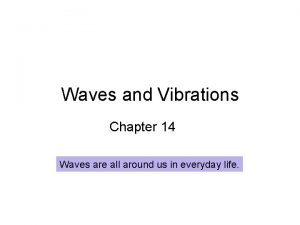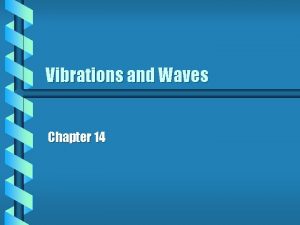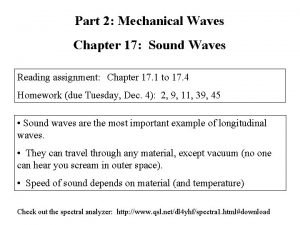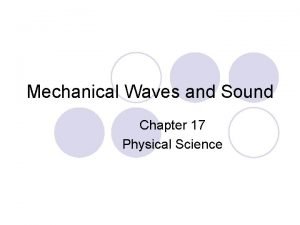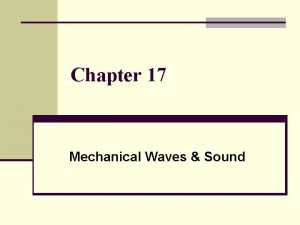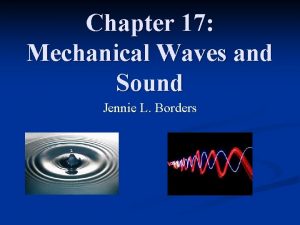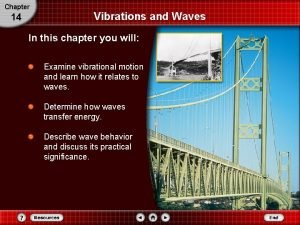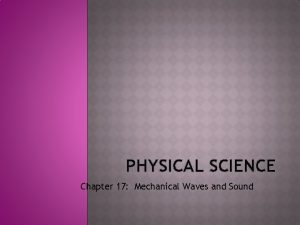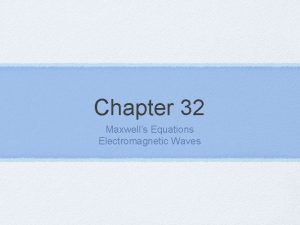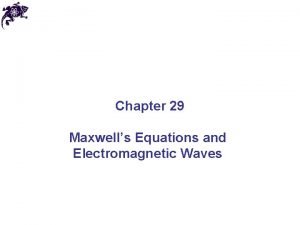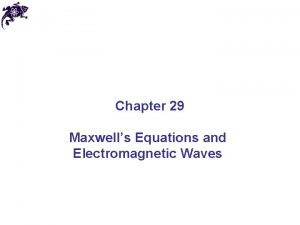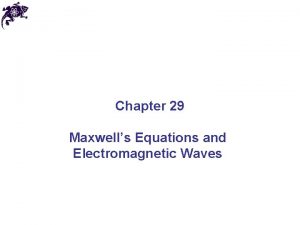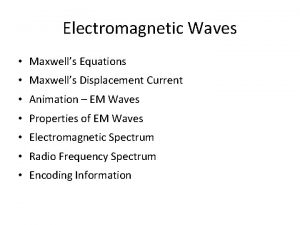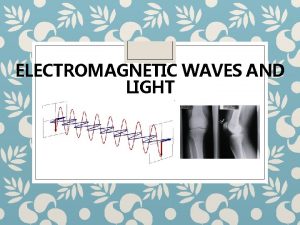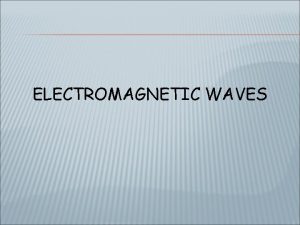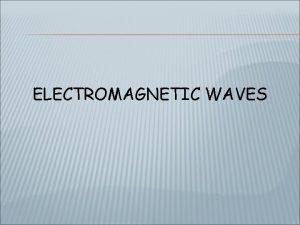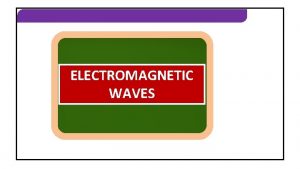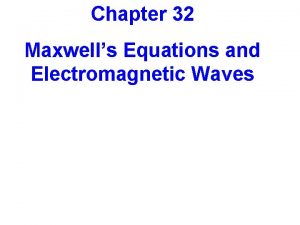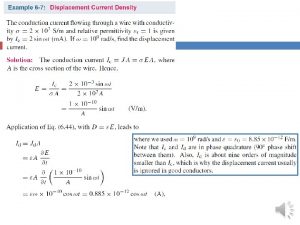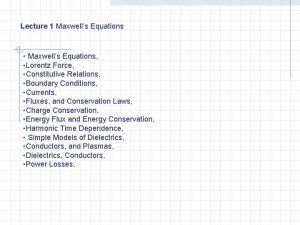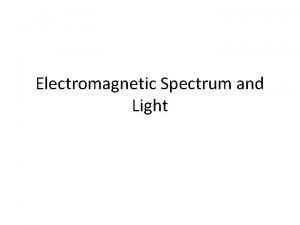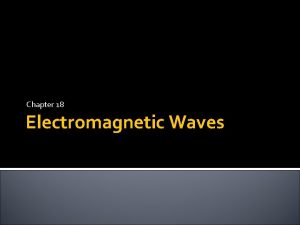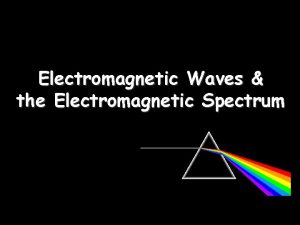Chapter 32 Maxwells Equations and Electromagnetic Waves Main

























































- Slides: 57

Chapter 32 Maxwell’s Equations and Electromagnetic Waves

Main Points of Chapter 32 • Maxwell’s Equations: • Gauss’s Law of Electricity • Gauss’s Law of Magnetism • Faraday’s Law of Induction • Maxwell’s Displacement Current and Ampère’s Law • Electromagnetic Waves and the Speed of Light

Gauss’ Law of Electricity enclosed The electric flux through a closed surface that encloses no net charge is zero.

Gauss’ Law for Magnetism • No magnetic monopoles (single magnetic charge) have ever been observed • Magnetic field lines must be continuous • The magnetic “charge” inside any closed surface must always be zero.

Gauss’ Law for Magnetism • Definition of magnetic flux: • Therefore, for any closed surface: This is Gauss’ law for magnetism.

Gauss’ Law for Magnetism Field lines for a bar magnet: • Similar to those for a magnetic dipole • But no magnetic charges, so all field lines are closed loops

Faraday’s Law of Induction A changing magnetic flux induces an electric field; this is a generalization of Faraday’s law. The electric field will exist regardless of whethere any conductors around. Although static electric fields are conservative fields, when the electric field produced by a changing magnetic field is a nonconservative field.

Ampère’s Law • Experimental observation: two parallel current-carrying wires exert forces on each other • Assumption: current creates a magnetic field • Field can be mapped out • Field makes circles around wire, direction given by right-hand rule

Ampère’s Law Field around a current-carrying wire:

Ampère’s Law In this case, there is a current through the surface whose edge is defined by the path. Ampère’s Law is the generalization of this, valid for any current and path:

The Maxwell Displacement Current • Ampère’s law has a flaw when currents are varying • One closed line can be the edge of an infinite number of surfaces • As long as currents through all surfaces are the same, no problem • But if current is varying this may not be true






Note: (1) A changing magnetic field creates an electric field (Faraday’s Law of Induction); (2) A changing electric field creates a magnetic field (Ampère’s Law: Displacement Current)

Maxwell’s Equations I. Gauss’ law for electric fields: equivalent to Coulomb’s law II. Gauss’ law for magnetic fields: no magnetic monopoles

Maxwell’s Equations III. Generalized Ampère’s law: changing electric flux creates magnetic field IV. Faraday’s law: changing magnetic flux creates electric field

Electromagnetic Waves • Electric and magnetic fields are coupled through Ampère’s and Faraday’s laws • Once created they can continue to propagate without further input • Only accelerating charges will create electromagnetic waves

Electromagnetic Waves Using Maxwell’s equations to find an equation for the electric field: This is a wave equation, with solution: And propagation speed:

Electromagnetic Waves This is the speed of light, c! The magnetic field obeys the same wave equation.

Electromagnetic Waves The amplitude of the magnetic field is related to the amplitude of the electric field: Also, the two fields are everywhere orthogonal:

Electromagnetic Waves • Electromagnetic waves are transverse – the E and B fields are perpendicular to the direction of propagation • The E and B fields are in phase



Electromagnetic Waves The electromagnetic spectrum:

Electromagnetic Waves • Electromagnetic waves travel more slowly through a medium by a factor n: • This defines n, the index of refraction.

Electromagnetic Waves • Except for ferromagnets, the speed can be written: So:

The Maxwell Displacement Current • This can be fixed by adding a term called the displacement current • Displacement current is zero unless there is a changing electric field Generalized form of Ampère’s law:

The Maxwell Displacement Current For example, a capacitor charging up: Surface 1 has a current going through it but Surface 2 does not But: electric flux is changing through Surface 2

Chapter 32 Electromagnetic Waves

Units of Chapter 32 • Changing Electric Fields Produce Magnetic Fields; Maxwell’s Equations • Production of Electromagnetic Waves • Light as an Electromagnetic Wave and the Electromagnetic Spectrum • Measuring the Speed of Light • Energy in EM Waves • Momentum Transfer and Radiation Pressure • Radio and Television; Wireless Communication

32. 1 Changing Electric Fields Produce Magnetic Fields; Maxwell’s Equations Maxwell’s equations are the basic equations of electromagnetism. They involve calculus; here is a summary: 1. Gauss’s law relates electric field to charge 2. A law stating there are no magnetic “charges” 3. A changing electric field produces a magnetic field 4. A magnetic field is produced by an electric current, and also by a changing electric field

32. 1 Changing Electric Fields Produce Magnetic Fields; Maxwell’s Equations Only one part of this is new – that a changing electric field produces a magnetic field. Ampère’s law relates the magnetic field around a current to the current through a surface.

32. 1 Changing Electric Fields Produce Magnetic Fields; Maxwell’s Equations In order for Ampère’s law to hold, it can’t matter which surface we choose. But look at a discharging capacitor; there is a current through surface 1 but none through surface 2:

32. 1 Changing Electric Fields Produce Magnetic Fields; Maxwell’s Equations Therefore, Ampère’s law is modified to include the creation of a magnetic field by a changing electric field – the field between the plates of the capacitor in this example.

32. 2 Production of Electromagnetic Waves Since a changing electric field produces a magnetic field, and a changing magnetic field produces an electric field, once sinusoidal fields are created they can propagate on their own. These propagating fields are called electromagnetic waves.

32. 2 Production of Electromagnetic Waves Oscillating charges will produce electromagnetic waves:

32. 2 Production of Electromagnetic Waves Far from the source, the waves are plane waves:

32. 2 Production of Electromagnetic Waves The electric and magnetic waves are perpendicular to each other, and to the direction of propagation.

32. 2 Production of Electromagnetic Waves When Maxwell calculated the speed of propagation of electromagnetic waves, he found: This is the speed of light in a vacuum.

32. 3 Light as an Electromagnetic Wave and the Electromagnetic Spectrum Light was known to be a wave; after producing electromagnetic waves of other frequencies, it was known to be an electromagnetic wave as well. The frequency of an electromagnetic wave is related to its wavelength: (32 -4)

32. 3 Light as an Electromagnetic Wave and the Electromagnetic Spectrum Electromagnetic waves can have any wavelength; we have given different names to different parts of the wavelength spectrum.

32. 4 Measuring the Speed of Light The speed of light was known to be very large, although careful studies of the orbits of Jupiter’s moons showed that it is finite. One important measurement, by Michelson, used a rotating mirror:

32. 4 Measuring the Speed of Light Over the years, measurements have become more and more precise; now the speed of light is defined to be: This is then used to define the meter.

32. 5 Energy in EM Waves Energy is stored in both electric and magnetic fields, giving the total energy density of an electromagnetic wave: (32 -5) Each field contributes half the total energy density. (32 -6 a)

32. 5 Energy in EM Waves This energy is transported by the wave.

32. 5 Energy in EM Waves The energy transported through a unit area per unit time is called the intensity: (32 -7) Its average value is given by:

32. 6 Momentum Transfer and Radiation Pressure In addition to carrying energy, electromagnetic waves also carry momentum. This means that a force will be exerted by the wave. The radiation pressure is related to the average intensity. It is a minimum if the wave is fully absorbed: And a maximum if it is fully reflected:

32. 7 Radio and Television; Wireless Communication This figure illustrates the process by which a radio station transmits information. The audio signal is combined with a carrier wave:

32. 7 Radio and Television; Wireless Communication The mixing of signal and carrier can be done two ways. First, by using the signal to modify the amplitude of the carrier (AM):

32. 7 Radio and Television; Wireless Communication Second, by using the signal to modify the frequency of the carrier (FM):

32. 7 Radio and Television; Wireless Communication At the receiving end, the wave is received, demodulated, amplified, and sent to a loudspeaker:

32. 7 Radio and Television; Wireless Communication The receiving antenna is bathed in waves of many frequencies; a tuner is used to select the desired one:

Summary of Chapter 32 • Maxwell’s equations are the basic equations of electromagnetism • Electromagnetic waves are produced by accelerating charges; the propagation speed is given by: • The fields are perpendicular to each other and to the direction of propagation.

Summary of Chapter 32 • The wavelength and frequency of EM waves are related: • The electromagnetic spectrum includes all wavelengths, from radio waves through visible light to gamma rays.
 Low amplitude wave
Low amplitude wave Example mechanical waves
Example mechanical waves Transfer of energy when a wave disappears into a surface
Transfer of energy when a wave disappears into a surface Mechanical waves and electromagnetic waves similarities
Mechanical waves and electromagnetic waves similarities Similarities of mechanical and electromagnetic waves
Similarities of mechanical and electromagnetic waves Mechanical wave and electromagnetic wave
Mechanical wave and electromagnetic wave Longitudinal vs transverse wave
Longitudinal vs transverse wave Electromagnetic waves vs mechanical waves
Electromagnetic waves vs mechanical waves Moeoe
Moeoe Maxwell equations
Maxwell equations Maxwells equations
Maxwells equations Maxwell's correction to ampere's law
Maxwell's correction to ampere's law Namblaa
Namblaa Ampere-maxwell law
Ampere-maxwell law Blger
Blger Electromagnetic waves: seeing objects and color
Electromagnetic waves: seeing objects and color Alternating current circuits and electromagnetic waves
Alternating current circuits and electromagnetic waves Compare and contrast p waves and s waves using venn diagram
Compare and contrast p waves and s waves using venn diagram A health inspector is measuring the intensity of a sound
A health inspector is measuring the intensity of a sound Energy density in electromagnetic waves
Energy density in electromagnetic waves Electromagnetic waves characteristics
Electromagnetic waves characteristics Electromagnetic waves frequency
Electromagnetic waves frequency Electromagnetic wave chart
Electromagnetic wave chart Electromagnetic waves powerpoint template
Electromagnetic waves powerpoint template Electromagnetic waves obey principle of .. *
Electromagnetic waves obey principle of .. * Teoria de james maxwell
Teoria de james maxwell Electromagnetic waves def
Electromagnetic waves def Em waves song lyrics
Em waves song lyrics Section 1 what are electromagnetic waves
Section 1 what are electromagnetic waves Power of an electromagnetic wave
Power of an electromagnetic wave Conclusion of electromagnetic waves
Conclusion of electromagnetic waves Electron spectrum
Electron spectrum Electromagnetic waves in water
Electromagnetic waves in water Electromagnetic waves formulas
Electromagnetic waves formulas Direction of electromagnetic waves
Direction of electromagnetic waves Concept of electromagnetic waves
Concept of electromagnetic waves Energy carried by electromagnetic waves
Energy carried by electromagnetic waves What is electromagnetic spectrum
What is electromagnetic spectrum Section 1 what are electromagnetic waves
Section 1 what are electromagnetic waves Electromagnetic spectrum table
Electromagnetic spectrum table What type of electromagnetic waves cause sunburns? *
What type of electromagnetic waves cause sunburns? * What is a semiconductor used for
What is a semiconductor used for Surface waves and body waves
Surface waves and body waves The difference between constructive and destructive waves
The difference between constructive and destructive waves What type of waves are sound waves? *
What type of waves are sound waves? * Is echolocation transverse or longitudinal
Is echolocation transverse or longitudinal Seismic waves are mechanical waves
Seismic waves are mechanical waves Chapter 18 electromagnetic spectrum and light
Chapter 18 electromagnetic spectrum and light Finding the main idea why were canals built?
Finding the main idea why were canals built? What is mechanical wave
What is mechanical wave How to fix forks in waves
How to fix forks in waves Chapter 14 vibrations and waves
Chapter 14 vibrations and waves Chapter 17 mechanical waves and sound
Chapter 17 mechanical waves and sound Chapter 17 physical science
Chapter 17 physical science Types of mechanical waves
Types of mechanical waves Mechanical waves
Mechanical waves Chapter 14 vibrations and waves
Chapter 14 vibrations and waves Which travels along a surface separating two media
Which travels along a surface separating two media








